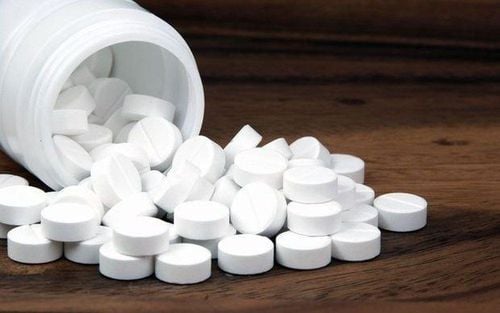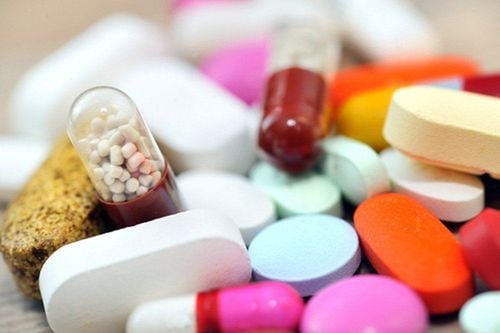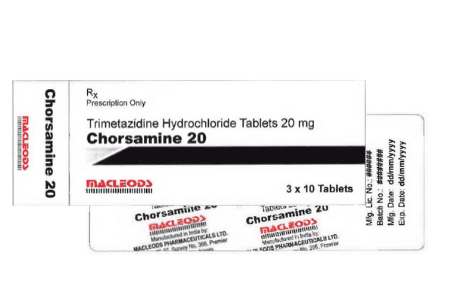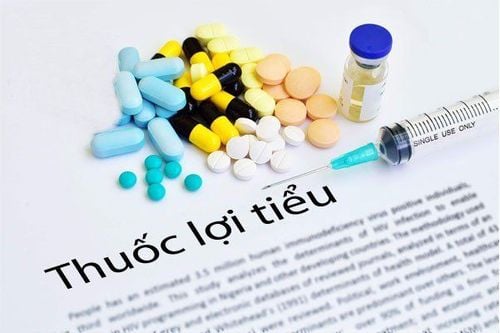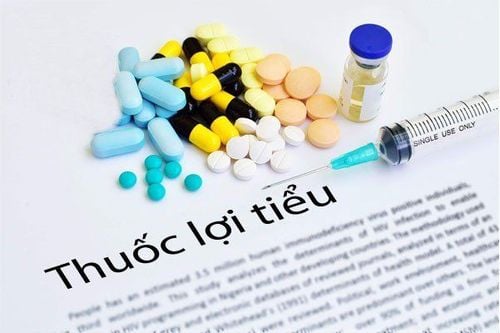This is an automatically translated article.
Prololsavi 10 is used in the treatment of hypertension, angina pectoris and chronic stable heart failure and the main ingredient is Bisoprolol fumarate. Let's find out more details about the uses, how to use the drug effectively and the notes when using Prololsavi 10 for treatment.
1. What is Prololsavi 10?
Prololsavi 10 belongs to the group of cardiovascular drugs, is made in the form of film-coated tablets packed in boxes of 3 blisters x 10 tablets.
Prololsavi 10 medicine has the main ingredient Bisoprolol fumarate 10mg and other excipients.
2. Indications for taking Prololsavi 10
Prololsavi 10 is used in the following cases:
Mild to moderate hypertension. May be used as monotherapy or in combination with other antihypertensive agents, especially diuretics. Chest pain. Treatment and support for stable chronic heart failure.
3. Dosage - How to take Prololsavi 10
Prololsavi 10 is used orally and prescribed by a doctor. The dose of Prololsavi 10 is determined individually in accordance with the heart rate and treatment results with the following reference doses:
In the treatment of angina and hypertension:
The usual single dose from 5 – 10mg Bisoprolol/day. The maximum dose of Bisoprolol is 20 mg/day. No dose adjustment is necessary in patients with mild to moderate hepatic and renal dysfunction. The starting dose may be 2.5 mg of Bisoprolol/day and the dose should be adjusted accordingly. The dose should not exceed 10 mg of Bisoprolol/day in patients with severe renal impairment (creatinine clearance less than 20 ml/min) or in patients with severe hepatic dysfunction. In the treatment of heart failure:
Initial dose: Use a single dose of 1.25 mg of Bisoprolol/day. If the patient tolerates the drug well, the dose of Bisoprolol can be doubled after 1 week of treatment and the dose is increased gradually over a period of 1-4 weeks to the maximum dose tolerated by the patient but should not be exceeded. 10mg Bisoprolol/day. No dose adjustment is necessary in elderly patients except in cases of significant renal and hepatic dysfunction. In case of overdose of Prololsavi 10:
When taking an overdose of Prololsavi 10, the most common is bradycardia and hypotension. Prololsavi 10 should be discontinued immediately and treatment with intravenous atropine (1 -2 mg), if necessary followed - followed by an intravenous dose of 25 mcg isoprenaline, possibly 1-5 mg glucagon . In addition, with an overdose of Bisoprolol, bronchospasm and heart failure may occur. Use aminophylline to treat bronchospasm by intravenous injection and to treat heart failure with diuretics and cardiovascular drugs (digitalis).
4. Contraindications to taking Prololsavi 10
Prololsavi 10 should not be used in the following cases:
Patients with hypersensitivity to Bisoprolol, beta-blockers or any of the excipients in the drug. Cardiogenic shock, decompensated heart failure. Atrioventricular conduction disorder. Sinus atrial block and sinus node disorder syndrome. Bradycardia before starting treatment. Low blood pressure. Metabolic acidosis. Patients with bronchial asthma, bronchitis and chronic respiratory diseases. The patient is being treated with MAO inhibitors. Peripheral circulatory disorders advanced stage. Raynaud's syndrome. Note:
In case the patient has an adrenal tumor, Bisoprolol can only be used after the blocker Prololsavi 10. Prololsavi 10 should be used with caution in patients with diabetes, long-term fasting with sharp fluctuations in blood sugar, patients with metabolic acidosis, first-degree AV block, angina pectoris. Prinzmetal chest. In patients with a personal and family history of psoriasis, beta-blockers should be given only after careful consideration of the benefits and risks.
5. Prololsavi drug interactions 10
The following are some of the reported Prololsavi 10 drug interactions:
Bisoprolol should not be combined with other beta-blockers. Concomitant treatment of Bisoprolol with catecholamine-depleting drugs (reserpine, alpha-methyldopa, clonidine, guanethidine) may result in a significant decrease in heart rate. In patients treated concomitantly with clonidine, if discontinuation of the drug is desired, it is recommended that Bisoprolol be discontinued for several days prior to discontinuation of clonidine. Concomitant use of Prololsavi 10 with myocardial relaxants or atrioventricular conduction inhibitors such as antiarrhythmic agents or some calcium antagonists may result in cardiac arrhythmias, heart failure, and hypotension. , slow heart rate. Concomitant administration of Bisoprolol with reserpine, alpha-methyldopa, guanfacine, clonidine or other glycosides may result in a significant decrease in heart rate. Rifampin in combination with Bisoprolol increases the metabolism and elimination of Bisoprolol fumarate, thereby shortening the half-life of the drug. Using Prololsavi 10 at the same time as insulin and oral hypoglycemic agents may increase the likelihood of Bisoprolol's effects. The most common symptoms of hypoglycemia are tachycardia that may be masked or mitigated. When used in combination, patients should have their blood sugar levels checked regularly.
6. Side effects when taking Prololsavi 10
During the use of Prololsavi 10 patients may experience some side effects that have been reported as follows:
Common:
Headache, dizziness. Dizziness, fatigue. Sweating Anxiety, sleep disturbances and strong dreams. Loss of concentration and depression. These symptoms are usually less severe and will go away within 1 to 2 weeks after starting treatment.
Uncommon:
Digestive disorders such as: Diarrhea, constipation, nausea & vomiting, stomach pain & abdominal pain, epigastric pain, gastric ulcer... Low blood pressure, slow pulse, atrioventricular conduction disturbances. Numbness and cold sensation in the extremities. Rare:
Skin reactions such as skin itching, erythema, swelling, hair loss... Muscle weakness, cramps Decreased tear secretion in case the patient wears contact lenses. Bronchospasm, dyspnea, increased respiratory resistance. The patient has a limp and Raynaud's phenomenon. At the start of treatment with Prololsavi 10 these symptoms may become more severe and myocardial failure may be more severe. In elderly patients with diabetes, signs of hypoglycemia, such as tachycardia, may be masked. An increase in serum triglycerides is usually present but is unlikely to be caused by Prololsavi 10. Slight increase in uric acid, BUN, creatinine, glucose, phosphorus, serum potassium, slight decrease in white blood cells and platelets.
7. Precautions when using Prololsavi 10
Here are some notes when using Prololsavi 10 for treatment:
Use Bisoprolol with caution in patients with congestive heart failure. However, in some patients with compensatory heart failure, if necessary, use Prololsavi 10 with caution. Patients with coronary artery disease may experience an increased incidence of angina, myocardial infarction, or ventricular arrhythmias upon abrupt discontinuation of beta-blocker therapy. Caution should be exercised when discontinuing treatment with Prololsavi 10 unless directed by a physician. Patients with bronchospasm who do not respond to or are intolerant of other antihypertensive therapy may receive Bisoprolol with caution due to its relative beta1 selectivity. Therefore, in this case, the drug can be used at the lowest dose, with an initial dose of 2.5 mg Bisoprolol / day. Bisoprolol can also be used concurrently with a beta 2 agonist (bronchodilator). Prololsavi 10 should be discontinued at least 48 hours before surgery. If drugs must be used during surgery, caution should be exercised with anesthetic agents such as ether, cyclopropan, and trichlorethylene. If Bisoprolol overdose, treat with atropine 1-2 mg I.V. Prololsavi 10 masked the manifestation of hypoglycemia, especially tachycardia. However, in patients with diabetes who are prescribed oral hypoglycemic agents or insulin, Bisoprolol should be used with caution. Prololsavi 10 may mask clinical signs of hyperthyroidism such as tachycardia. Abrupt discontinuation of Prololsavi 10 may precipitate an episode of thyrotoxicosis. Prololsavi 10 should not be used by women who are pregnant or breastfeeding. The mother should stop treatment with Bisoprolol 72 hours before the due date, because the drug has the potential to cause hypoglycaemia, bradycardia, and hypotension in the neonate. If treatment with Bisoprolol cannot be terminated, the neonate should be observed for 48-72 hours after birth. Because Prololsavi 10 has antihypertensive effect, depending on the individual may affect the ability to drive and use machines. Usually, hypotension occurs at the start of treatment with the drug. Prololsavi 10 is used in the treatment of hypertension, stable angina pectoris and chronic heart failure and the main ingredient is Bisoprolol fumarate. To ensure the effectiveness of treatment and avoid unwanted side effects, patients need to strictly follow the instructions of the doctor, professional pharmacist.
Follow Vinmec International General Hospital website to get more health, nutrition and beauty information to protect the health of yourself and your loved ones in your family.
Please dial HOTLINE for more information or register for an appointment HERE. Download MyVinmec app to make appointments faster and to manage your bookings easily.




